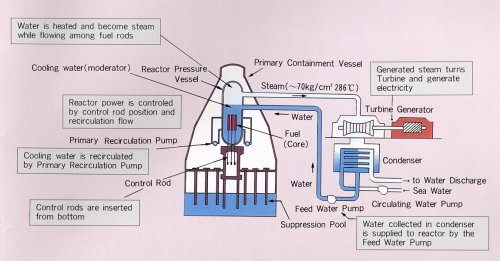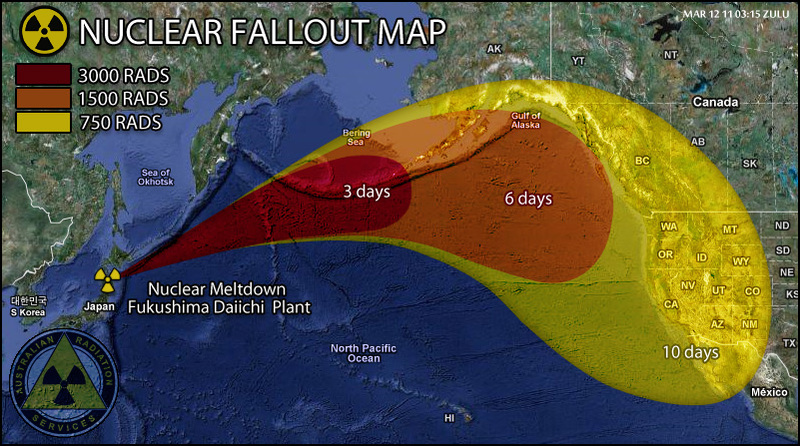Radioactive leak after nuclear power plant explosion in Japan

The Japanese government said radiation emanating from the plant appeared to have decreased after Saturday's blast, which produced a cloud of white smoke that obscured the complex. But the danger was grave enough that officials pumped seawater into the reactor to avoid disaster and moved 170,000 people from the area. Japan's nuclear safety agency then reported an emergency at another reactor unit, the third in the complex to have its cooling systems malfunction.
Japan dealt with the nuclear threat as it struggled to determine the scope of the earthquake, the most powerful in its recorded history, and the tsunami that ravaged its northeast Friday with breathtaking speed and power. The official count of the dead was 686, but the government said the figure could far exceed 1,000. Teams searched for the missing along hundreds of miles (kilometers) of the Japanese coast, and thousands of hungry survivors huddled in darkened emergency centers that were cut off from rescuers and aid. At least a million households had gone without water since the quake struck. Large areas of the countryside were surrounded by water and unreachable.
The explosion at the nuclear plant, Fukushima Dai-ichi, 170 miles (274 kilometers) northeast of Tokyo, appeared to be a consequence of steps taken to prevent a meltdown after the quake and tsunami knocked out power to the plant, crippling the system used to cool fuel rods there.
The blast destroyed the building housing the reactor, but not the reactor itself, which is enveloped by stainless steel 6 inches (15 centimeters) thick. (AP)
The Japanese cabinet secretary, Yukio Edano, has been speaking on state TV. He said the third reactor at the Fukushima No. I plant was in danger but attempts were under way for a controlled release of air. (BBC)
US nuclear experts warn that pumping sea water to cool a quake-hit Japanese nuclear reactor is an "act of desperation" that may foreshadow a Chernobyl-like disaster, AFP reports. "The situation has become desperate enough that they apparently don't have the capability to deliver fresh water or plain water to cool the reactor and stabilise it, and now, in an act of desperation, are having to resort to diverting and using sea water," said Robert Alvarez, who works on nuclear disarmament at the Institute for Policy Studies.
There have been reports that both radioactive iodine and cesium have been detected around the reactor, and that could indicate that there is essentially no water left to cool this reaction. Operators are preparing to release radioactive steam from the number three reactor at Fukushima No. 1 plant, after the cooling system failed there.
The worst scenario seems to be true now that the outer jacket of the Japanese I Fukushima reactor was destroyed by an explosion. The Japanese now expect that the reactor will indeed melt, as happened in 1986 with the Russian nuclear power plant in Chernobyl. Residents in the surrounding area fled, but do not know where because the atomic state of emergency now FIVE Japanese nuclear power plants has been imposed. The United States has already begun evacuating its citizens from Japan. The radioactivity was 1000 times higher this morning than usual, allowing 45,000 people in the area were evacuated. Meanwhile, the authorities still claim that there is "no danger to public health". (EarthWatcher)

According to Reuters, the number of people exposed to radiation near Fukushima No. 1 nuclear plant could reach 160, an official from the Japan Nuclear and Industrial Safety Agency has said. Nine people have shown signs of possible exposure. People who lived within the evacuation zone or showed signs of radiation exposure were separated from others seeking shelter.
Fukushima has two nuclear plants; Fukushima No. 1, which has six reactors (three of which were offline at the time of the quake) and Fukushima No. 2, which has four reactors.
A theoretical physicist today calls the Japan reactor explosion a "Chernobyl in the making." Speaking to ABC News, theoretical physicist Michio Kaku said, "This could be a Chernobyl in the making. We are now going into uncharted territory, we are thinking the unthinkable." These inflamatory statements came after hydrogen released from the super-hot nuclear rods ignited, creating an explosion at the plant that was disabled after the 8.9 earthquake and tsunami. There is a six-mile area being cleared around the reactor. Medical iodine is being readied. If there is a radioactive release of dangerous iodine, the inert iodine being distributed would prevent the body from absorbing as much of the toxins. California is downwind from Japan, as the jet stream reaches eastward across the Pacific, but right now, it appears any effects from radioactive releases would be extremely local, possibly within 20 miles of the nuclear core. (Fox40)
The scale of the radiation leak at the station cannot be known for sure, as authorities usually try to minimize their assessments of the danger in order to avoid causing panic, says Dr Winfrid Eisenberg from the International Association of Physicians Campaigning for the Prevention of Nuclear War.
“But even the amount of radiation which was published is big enough to bring harm to people around, and especially to children and unborn children, embryos and fetuses,” said Dr Eisenberg. (RT)

- Latest press release by Japan Nuclear and Industrial Safety Agency – Seismic Damage Information (the 16th Release) (As of 0:00 March 13, 2011)
- Nuclear Reactor Maps: Fukushima-Daiichi (NucTrans)
- Jet stream forecast Website.
- EPA
————
Japan brings 140,000 people to safety (Spiegel)
Meltdown Caused Nuke Plant Explosion: Safety Body (Nikkei)
Japanese Government Confirms Meltdown (Stratfor)
Physicist: Japan Reactor Is a "Chernobyl in the Making" (Fox40)
MOX fuel loaded into Tokyo Electric's old Fukushima reactor (JapanToday)
Possible Fukushima Nuclear Fallout Projections For the U.S. Based on Wind Patterns, Meltdown Confirmed (IntelHub)
Core of quake-damaged reactor partially melts (MSNBC)

Commenting rules and guidelines
We value the thoughts and opinions of our readers and welcome healthy discussions on our website. In order to maintain a respectful and positive community, we ask that all commenters follow these rules.